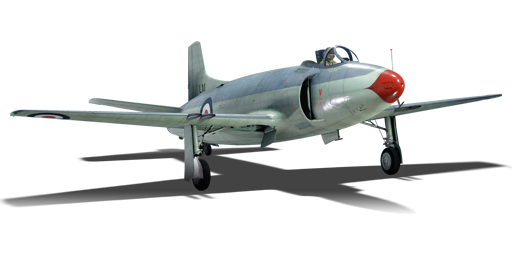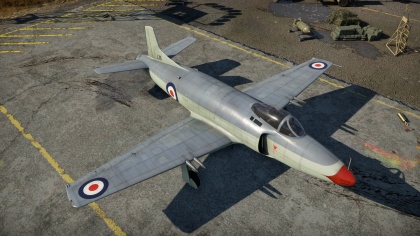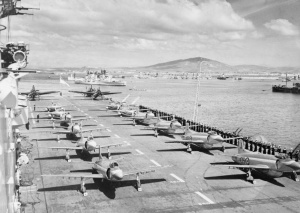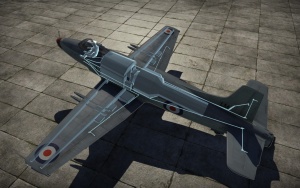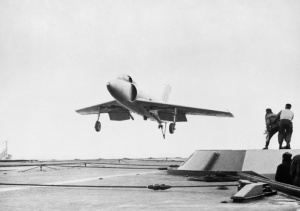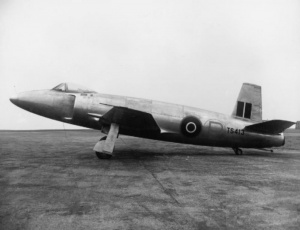Difference between revisions of "Attacker FB 1"
Inceptor57 (talk | contribs) (→Description: Updated to new format) |
m (Spaded stats) (Tag: Visual edit) |
||
| (33 intermediate revisions by 14 users not shown) | |||
| Line 1: | Line 1: | ||
| − | + | {{Specs-Card|code=attaker_fb1}} | |
| − | |||
| − | |||
| − | |||
| − | |||
| − | {{Specs-Card | ||
| − | |code=attaker_fb1 | ||
| − | |||
| − | }} | ||
== Description == | == Description == | ||
| − | <!-- ''In the description, the first part | + | <!--''In the description, the first part needs to be about the history of and the creation and combat usage of the aircraft, as well as its key features. In the second part, tell the reader about the aircraft in the game. Insert screenshot of the vehicle. If the novice player does not remember the vehicle by name, he will immediately understand what kind of vehicle it is talking about.''--> |
| − | + | ||
| + | [[File:GarageImage_{{PAGENAME}}.jpg|420px|thumb|left]] | ||
| + | {{break}} | ||
| + | The '''{{Specs|name}}''' is a Rank {{Specs|rank}} British jet fighter {{Battle-rating|2}}. It was introduced in [[Update 1.49 "Weapons of Victory"]]. | ||
[[File:HMS Eagle (R05) flight deck at Gibraltar c1953.jpg|thumbnail|right|Attackers on-board HMS Eagle ]] | [[File:HMS Eagle (R05) flight deck at Gibraltar c1953.jpg|thumbnail|right|Attackers on-board HMS Eagle ]] | ||
| − | + | Following on from the Sea Fury in the Fleet Air Arm branch is the first operational carrier based jet within the Royal Navy’s arsenal, the Supermarine Attacker. The Attacker is Britain's first Naval jet and offers good all round performance for a first generation jet design as well as ground attack and fighter bomber payload capabilities for a variety of situations. Available to research after the Sea Fury, the Attacker is a different approach | |
| + | The most unique and unusual trait of the Attacker is its tail dragger configuration and wing mounted armament. As the wing and undercarriage was shared with another of Supermarine’s aircraft, the Spiteful, the Attacker is the only British jet of the period to have a wing mounted cannon armament. Unlike the other British jet fighters which adopt nose mounted configurations, the 4 x 20 mm Hispano Mk V cannons on the Attacker do require careful use of convergence much like the Sea Fury and Seafires before it as a result of their positioning. | ||
| + | [[File:FighterImage_Shot 2015 07 28 13 04 55.jpg|thumbnail|right|X-Ray View of the Attacker FB.Mk 1]] | ||
| + | Mounted in pairs with two in each wing, 624 rounds of Hispano ammunition is available to the cannons providing a greater capacity than the piston fighters before it. The Attacker can also amount 2 x 500 lb or 1,000 lb bombs as well as 12 x 76 mm RP-3 rockets with the GLBC Mk 3 and GRC Mk 8 Modifications respectively. This combined with the “Universal” or “Ground Targets” belts allows the Attacker to live up to its namesake, should pilots choose to use it in the fast ground attack fighter-bomber role. | ||
| + | |||
| + | Utilizing the ''Air Targets'' be to jet fighter aircraft by comparison to the Meteors, Vampire or Venom. | ||
| + | lt and adopting the pure fighter role in the Attacker is equally as effective thanks to the aircraft's good all round performance, a "Bubble" canopy that offers good all round visibility for simulator pilots as well as a set of air brakes situated in the wings to aid in slowing the aircraft and energy management. | ||
| + | The unusual undercarriage is also very forgiving upon landing, both on land bases and aircraft carriers due to the wide track. However, this can also prove to be a hindrance for fans of the Simulator Battles game mode and pilots who prefer cockpit view, as the aircraft is indeed a "tail dragger". This causes extremely restricted view on the ground and when landing, especially on a carrier. | ||
== General info == | == General info == | ||
| − | === Flight | + | === Flight Performance === |
| − | + | <!--''Describe how the aircraft behaves in the air. Maximum speed, maneuverability, speed and allowable loads - these are the most important characteristics of the vehicle.''--> | |
| − | <!-- ''Describe how the aircraft behaves in the air. | + | {| class="wikitable" style="text-align:center" |
| − | + | |- | |
| − | {| class="wikitable" style="text-align:center" | + | ! colspan="8" | Characteristics |
| − | ! | + | |- |
| + | ! colspan="8" | ''Stock'' | ||
| + | |- | ||
! colspan="2" | Max Speed<br>(km/h at 0 m - sea level) | ! colspan="2" | Max Speed<br>(km/h at 0 m - sea level) | ||
| − | ! rowspan="2" | Max altitude<br>( | + | ! rowspan="2" | Max altitude<br>(meters) |
! colspan="2" | Turn time<br>(seconds) | ! colspan="2" | Turn time<br>(seconds) | ||
| − | ! colspan="2" | Rate of climb<br>( | + | ! colspan="2" | Rate of climb<br>(meters/second) |
| − | ! rowspan="2" | Take-off run<br>( | + | ! rowspan="2" |Take-off run<br>(meters) |
| + | |- | ||
| + | ! AB | ||
| + | ! RB | ||
| + | ! AB | ||
| + | ! RB | ||
| + | ! AB | ||
| + | ! RB | ||
| + | |- | ||
| + | | 885 || 859 || 12,191 || 26.2 || 26.9 || 22.8 || 21.5 || 950 | ||
|- | |- | ||
| − | ! | + | ! colspan="8" | ''Upgraded'' |
| + | |- | ||
| + | ! colspan="2" | Max Speed<br>(km/h at 0 m - sea level) | ||
| + | ! rowspan="2" |Max altitude (meters) | ||
| + | ! colspan="2" | Turn time (seconds) | ||
| + | ! colspan="2" | Rate of climb<br>(meters/second) | ||
| + | ! rowspan="2" |Take-off run (meters) | ||
|- | |- | ||
| − | ! | + | ! AB |
| − | + | ! RB | |
| + | ! AB | ||
| + | ! RB | ||
| + | ! AB | ||
| + | ! RB | ||
|- | |- | ||
| − | + | |936||922|| 12,191 ||23.9||25.0||33.8||28.0|| 950 | |
| − | | 936 || 922 || 23.9 || 25.0 || 33.8 || 28.0 | ||
|- | |- | ||
|} | |} | ||
| − | ==== Details ==== | + | ====Details==== |
| − | {| class="wikitable" style="text-align:center | + | {| class="wikitable" style="text-align:center" |
|- | |- | ||
| − | ! colspan=" | + | ! colspan="5" | Features |
|- | |- | ||
| − | ! Combat | + | ! Combat flap |
| + | ! Take-off flap | ||
| + | ! Landing flap | ||
| + | ! Air brakes | ||
| + | ! Arrestor gear | ||
|- | |- | ||
| − | | ✓ || ✓ || ✓ || ✓ || ✓ | + | | ✓ || ✓ || ✓ || ✓ || ✓ <!-- ✓ --> |
|- | |- | ||
|} | |} | ||
| − | {| class="wikitable" style="text-align:center | + | {| class="wikitable" style="text-align:center" |
|- | |- | ||
| − | ! colspan=" | + | ! colspan="5" | Limits |
|- | |- | ||
| − | ! rowspan="2" | | + | ! rowspan="2" | Wing-break speed<br>(km/h) |
| − | ! rowspan="2" | Gear (km/h) | + | ! rowspan="2" | Gear limit<br>(km/h) |
| − | ! | + | ! rowspan="2" | Combat flap<br> (km/h) |
! colspan="2" | Max Static G | ! colspan="2" | Max Static G | ||
|- | |- | ||
| − | + | ! + | |
| + | ! - | ||
|- | |- | ||
| − | | | + | | 895 || 351 || 520|| ~16 || ~9 |
|- | |- | ||
|} | |} | ||
| Line 67: | Line 94: | ||
{| class="wikitable" style="text-align:center" | {| class="wikitable" style="text-align:center" | ||
|- | |- | ||
| − | ! colspan="4" | Optimal velocities | + | ! colspan="4" | Optimal velocities |
|- | |- | ||
| − | ! Ailerons | + | ! Ailerons<br>(km/h) |
| + | ! Rudder<br>(km/h) | ||
| + | ! Elevators<br>(km/h) | ||
| + | ! Radiator<br>(km/h) | ||
|- | |- | ||
| − | | < 491 || < 600 || < 620 || | + | | < 491 || < 600 || < 620 || > 250 |
|- | |- | ||
|} | |} | ||
| − | + | <!-- | |
| − | |||
{| class="wikitable" style="text-align:center" | {| class="wikitable" style="text-align:center" | ||
|- | |- | ||
| − | ! colspan="3" | | + | ! colspan="3" | Compressor (RB/SB) |
| − | |||
|- | |- | ||
| − | ! colspan=" | + | ! colspan="3" | Setting 1 |
| − | |||
|- | |- | ||
| − | + | ! Optimal altitude | |
| − | + | ! 100% Engine power | |
| + | ! WEP Engine power | ||
|- | |- | ||
| − | + | | ?,??? m || ??? hp || ?,??? hp | |
| − | |||
|- | |- | ||
| − | ! | + | ! colspan="3" | Setting 2 |
| − | |||
|- | |- | ||
| − | + | ! Optimal altitude | |
| − | + | ! 100% Engine power | |
| + | ! WEP Engine power | ||
|- | |- | ||
| − | + | | ?,??? m || ?,??? hp || ?,??? hp | |
| − | |||
|- | |- | ||
| − | ! | + | ! colspan="3" | Setting 3 |
| − | |||
|- | |- | ||
| − | + | ! Optimal altitude | |
| − | + | ! 100% Engine power | |
| + | ! WEP Engine power | ||
|- | |- | ||
| − | | | + | | ?,??? m || ?,??? hp || ?,??? hp |
| − | + | |- | |
| − | |- | + | |} --> |
| − | |} | ||
=== Survivability and armour === | === Survivability and armour === | ||
| − | + | <!--''Examine the survivability of the aircraft. Note how vulnerable the structure is and how secure the pilot is, whether the fuel tanks are armoured. Describe the armour, if there is any, also mention the vulnerability of other critical aircraft systems.''--> | |
| − | <!-- ''Examine the survivability of the aircraft. Note how vulnerable the structure is and how secure the pilot is, whether the fuel tanks are armoured | ||
| − | * 38 mm Bulletproof glass - | + | * 38 mm Bulletproof glass - Armored windscreen |
| − | * 12.7 mm Steel - | + | * 12.7 mm Steel - Armor plate behind the pilot's seat |
| − | |||
| − | |||
| − | |||
== Armaments == | == Armaments == | ||
| − | |||
=== Offensive armament === | === Offensive armament === | ||
| − | + | <!--''Describe the offensive armament of the aircraft, if any. Describe how effective the cannons and machine guns are in a battle, and also what belts or drums are better to use. If there is no offensive weaponry, delete this subsection.''--> | |
| − | <!-- ''Describe the offensive armament of the aircraft, if any. Describe how effective the cannons and machine guns are in a battle, and also what belts or drums are better to use. If there is no offensive weaponry, delete this subsection.'' --> | ||
| − | |||
{{main|Hispano Mk.V (20 mm)}} | {{main|Hispano Mk.V (20 mm)}} | ||
| Line 133: | Line 151: | ||
=== Suspended armament === | === Suspended armament === | ||
| − | + | <!--''Describe the aircraft's suspended armament: additional cannons under the wings, bombs, rockets and torpedoes. This section is especially important for bombers and attackers. If there is no suspended weaponry remove this subsection.''--> | |
| − | <!-- ''Describe the aircraft's suspended armament: additional cannons under the wings, bombs, rockets and torpedoes. This section is especially important for bombers and attackers. If there is no suspended weaponry remove this subsection.'' --> | + | ''Main article: '''[[:Category:Suspended armaments|Bombs]]''''' |
| − | |||
| − | The '''''{{PAGENAME}}''''' can be outfitted with the following | + | The '''''{{PAGENAME}}''''' can be outfitted with the following ordinance: |
| − | + | * 2 x G.P. 500 lb Mk.IV bombs (1,000 lb total) | |
| − | * 2 x 500 lb | + | * 2 x G.P. 1,000 lb Mk.I bombs (2,000 lb total |
| − | * 2 x 1,000 lb | + | * 12 x 76 mm RP-3 rockets |
| − | * 12 x RP-3 rockets | + | <!-- |
| + | === Defensive armament === | ||
| + | ''Defensive armament with turret machine guns or cannons, crewed by gunners. Examine the number of gunners and what belts or drums are better to use. If defensive weaponry is not available remove this subsection.'' | ||
| + | --> | ||
| − | == Usage in battles == | + | == Usage in the battles == |
| − | <!-- ''Describe the tactics of playing in | + | <!--''Describe the tactics of playing in an aircraft, the features of using vehicles in a team and advice on tactics. Refrain from creating a "guide" - do not impose a single point of view but give the reader food for thought. Examine the most dangerous enemies and give recommendations on fighting them. If necessary, note the specifics of the game in different modes (AB, RB, SB).''--> |
| − | + | ===Modules=== | |
| + | {| class="wikitable" | ||
| + | ! colspan="1" | Tier | ||
| + | ! colspan="2" | Flight performance | ||
| + | ! colspan="1" | Survivability | ||
| + | ! colspan="2" | Weaponry | ||
| + | |- | ||
| + | | I | ||
| + | | Fuselage Repair | ||
| + | | | ||
| + | | | ||
| + | | Offensive 20 mm | ||
| + | | | ||
| + | |- | ||
| + | | II | ||
| + | | | ||
| + | | Compressor | ||
| + | | Airframe | ||
| + | | | ||
| + | | GLBC mk.3 | ||
| + | |- | ||
| + | | III | ||
| + | | Wings Repair | ||
| + | | Engine | ||
| + | | | ||
| + | | New 20 mm Cannons | ||
| + | | | ||
| + | |- | ||
| + | | IV | ||
| + | | G-Suit | ||
| + | | Cover | ||
| + | | | ||
| + | | | ||
| + | | GRC mk.8 | ||
| + | |- | ||
| + | |} | ||
| + | [[File:FighterImage_Supermarine 510 landing on HMS Illustrious (R87) 1950.jpg|thumbnail|right|The Supermarine 510 swept wing development of the Attacker would ultimately lead to the Swift]] | ||
| − | |||
| − | |||
| − | |||
| − | |||
| − | |||
| − | |||
| − | |||
| − | |||
| − | |||
| − | |||
| − | |||
| − | |||
| − | |||
| − | |||
| − | |||
| − | |||
| − | |||
| − | |||
| − | |||
| − | |||
| − | |||
| − | |||
| − | |||
| − | |||
| − | |||
| − | |||
| − | |||
=== Pros and cons === | === Pros and cons === | ||
| − | <!-- '' | + | <!--''Summarize and briefly evaluate the vehicle in terms of its characteristics and combat effectiveness. Mark its pros and cons in the bulleted list. Do not use more than 6 points for each of the characteristics. Avoid using categorical definitions such as "bad", "good" and the like - they have a substitution in the form of softer "inadequate", "effective".''--> |
'''Pros:''' | '''Pros:''' | ||
| − | * Powerful armament | + | * Powerful armament of 4 x 20 mm Hispano Mk V cannons |
| − | * Wide track undercarriage for easier | + | * Wide track undercarriage for easier and more stable landings |
| − | * | + | * Carrier arresting hook for extra versatility on realistic and simulator battle maps |
| − | * Clear visibility cockpit with good all | + | * Clear visibility cockpit with good all round vision |
* Good ground strike payloads for multi-role capabilities | * Good ground strike payloads for multi-role capabilities | ||
* Air brakes | * Air brakes | ||
| − | |||
'''Cons:''' | '''Cons:''' | ||
| − | * Poor | + | * Poor Acceleration due to early jet technology |
| − | * | + | * Cannons all mounted in the wings whilst other jets offer nose mounted armament |
| − | * | + | * "Tail dragger" configuration that makes for difficult carrier take-off's and landings, particularly in simulator battle |
| + | * Slow rate of climb | ||
== History == | == History == | ||
| − | <!-- ''Describe the history of the creation and combat usage of the aircraft in more detail than in the introduction. If the historical reference turns out to be too | + | <!--''Describe the history of the creation and combat usage of the aircraft in more detail than in the introduction. If the historical reference turns out to be too big, take it to a separate article, taking a link to an article about the vehicle and adding a block "/ historical reference" (example: https://wiki.warthunder.com/Name-vehicles/historical reference) and add a link to it here using the <code>main</code> template. Be sure to include links to sources at the end of the article.''--> |
| − | |||
[[File:FighterImage_Supermarine Attacker TS413 on the ground 1947.jpg|thumbnail|left|Supermarine Type 398]] | [[File:FighterImage_Supermarine Attacker TS413 on the ground 1947.jpg|thumbnail|left|Supermarine Type 398]] | ||
| − | The Attacker was part of the first generation of jet aircraft to enter service with the Royal Navy and had the distinction of being the first operational combat jet on a British carrier. Whilst the Royal Air Force was already equipped with Meteors and Vampires, the Fleet Air Arm fell behind due to the difficulty of operating such a radical new technology from the | + | The Attacker was part of the first generation of jet aircraft to enter service with the Royal Navy and had the distinction of being the first operational combat jet on a British carrier. Whilst the Royal Air Force was already equipped with Meteors and Vampires, the Fleet Air Arm fell behind due to the difficulty of operating such a radical new technology from the Navy’s existing carriers. This was partially the reasoning the FAA showed interest in the Sea Fury and the later Griffon Seafires as a “make-do” solution. |
| − | |||
| − | |||
| − | |||
| − | |||
| − | |||
| − | |||
| − | |||
| − | |||
| − | |||
| − | |||
| − | |||
| − | |||
| − | |||
| − | + | After trials with the De Havilland Sea Vampire, the Navy wanted a jet aircraft that could be operated from its current ships. Supermarine’s failed Spitfire replacement, the Spiteful, was rejected by both the FAA and RAF due to already sufficient stocks of operational piston engine aircraft. However, this led to a jet engine design incorporating the same wing and undercarriage from the Spiteful, along with a tail wheel configuration as a result, and utilized a Rolls Royce Nene jet engine. | |
| − | + | This rather primitive and rushed design was operational from 1951; however it had an extremely short career - being taken out of front-line service by 1954. This was primarily due to the aircraft's limitations being a “tail-dragger” that made operating on anything other than the deck of an aircraft carrier problematic because of the jet exhaust. The rear tail wheel only made the already hazardous task of operating a jet on a carrier even more problematic for pilots. | |
| − | The | + | The Attacker quickly became superseded by the Hawker Sea Hawk and De Havilland Sea Venom, both of which were much more modern and refined designs featuring more powerful engines, tricycle undercarriages, and possessing superior performance. The Attacker did however serve as the base of Supermarine’s first swept wing jet for the RAF, the Swift, as can be seen by the similarity of the nose and fuselage. It would also lead to the more successful Supermarine Scimitar naval jet fighter in the later part of the 1950's. |
| − | + | Whilst the Attacker saw no major service and was relatively short lived from an operational standpoint, it nonetheless holds the distinction of being the very first of a very new breed of carrier borne aircraft and the first chapter in a rapidly advancing era of aviation evolution. | |
| − | |||
| − | |||
| − | |||
== Media == | == Media == | ||
| − | + | ''An excellent addition to the article will be video guides, as well as screenshots from the game and photos.'' | |
| − | ; | + | == Read also == |
| − | + | <!--''Links to the articles on the War Thunder Wiki that you think will be useful for the reader, for example,'' | |
| − | * | + | * ''reference to the series of the aircraft;'' |
| + | * ''links to approximate analogues of other nations and research trees.'' | ||
| + | ''ETC.''--> | ||
| − | + | * [http://warthunder.com/en/devblog/current/772 [Devblog<nowiki>]</nowiki> Attacker FB.1 and M10 & M36 Slugger] | |
| − | < | + | * [http://warthunder.com/en/news/3233-vehicle-profile-supermarine-attacker-en [Vehicle Profile<nowiki>]</nowiki> Supermarine Attacker] |
| − | * | ||
| − | |||
| − | + | == Sources == | |
| + | ''Paste links to sources and external resources, such as:'' | ||
| − | |||
| − | |||
* ''topic on the official game forum;'' | * ''topic on the official game forum;'' | ||
| − | * ''other literature.'' | + | * ''page on aircraft encyclopedia;'' |
| − | + | * ''other literature.'' | |
| − | |||
| − | |||
| − | |||
| − | + | {{Britain jet aircrafts}} | |
| − | {{Britain jet | ||
Revision as of 16:02, 15 May 2019
Contents
Description
The Attacker FB 1 is a Rank V British jet fighter
with a battle rating of 7.0 (AB/RB) and 7.3 (SB). It was introduced in Update 1.49 "Weapons of Victory".
Following on from the Sea Fury in the Fleet Air Arm branch is the first operational carrier based jet within the Royal Navy’s arsenal, the Supermarine Attacker. The Attacker is Britain's first Naval jet and offers good all round performance for a first generation jet design as well as ground attack and fighter bomber payload capabilities for a variety of situations. Available to research after the Sea Fury, the Attacker is a different approach The most unique and unusual trait of the Attacker is its tail dragger configuration and wing mounted armament. As the wing and undercarriage was shared with another of Supermarine’s aircraft, the Spiteful, the Attacker is the only British jet of the period to have a wing mounted cannon armament. Unlike the other British jet fighters which adopt nose mounted configurations, the 4 x 20 mm Hispano Mk V cannons on the Attacker do require careful use of convergence much like the Sea Fury and Seafires before it as a result of their positioning.
Mounted in pairs with two in each wing, 624 rounds of Hispano ammunition is available to the cannons providing a greater capacity than the piston fighters before it. The Attacker can also amount 2 x 500 lb or 1,000 lb bombs as well as 12 x 76 mm RP-3 rockets with the GLBC Mk 3 and GRC Mk 8 Modifications respectively. This combined with the “Universal” or “Ground Targets” belts allows the Attacker to live up to its namesake, should pilots choose to use it in the fast ground attack fighter-bomber role.
Utilizing the Air Targets be to jet fighter aircraft by comparison to the Meteors, Vampire or Venom. lt and adopting the pure fighter role in the Attacker is equally as effective thanks to the aircraft's good all round performance, a "Bubble" canopy that offers good all round visibility for simulator pilots as well as a set of air brakes situated in the wings to aid in slowing the aircraft and energy management.
The unusual undercarriage is also very forgiving upon landing, both on land bases and aircraft carriers due to the wide track. However, this can also prove to be a hindrance for fans of the Simulator Battles game mode and pilots who prefer cockpit view, as the aircraft is indeed a "tail dragger". This causes extremely restricted view on the ground and when landing, especially on a carrier.
General info
Flight Performance
| Characteristics | |||||||
|---|---|---|---|---|---|---|---|
| Stock | |||||||
| Max Speed (km/h at 0 m - sea level) |
Max altitude (meters) |
Turn time (seconds) |
Rate of climb (meters/second) |
Take-off run (meters) | |||
| AB | RB | AB | RB | AB | RB | ||
| 885 | 859 | 12,191 | 26.2 | 26.9 | 22.8 | 21.5 | 950 |
| Upgraded | |||||||
| Max Speed (km/h at 0 m - sea level) |
Max altitude (meters) | Turn time (seconds) | Rate of climb (meters/second) |
Take-off run (meters) | |||
| AB | RB | AB | RB | AB | RB | ||
| 936 | 922 | 12,191 | 23.9 | 25.0 | 33.8 | 28.0 | 950 |
Details
| Features | ||||
|---|---|---|---|---|
| Combat flap | Take-off flap | Landing flap | Air brakes | Arrestor gear |
| ✓ | ✓ | ✓ | ✓ | ✓ |
| Limits | ||||
|---|---|---|---|---|
| Wing-break speed (km/h) |
Gear limit (km/h) |
Combat flap (km/h) |
Max Static G | |
| + | - | |||
| 895 | 351 | 520 | ~16 | ~9 |
| Optimal velocities | |||
|---|---|---|---|
| Ailerons (km/h) |
Rudder (km/h) |
Elevators (km/h) |
Radiator (km/h) |
| < 491 | < 600 | < 620 | > 250 |
Survivability and armour
- 38 mm Bulletproof glass - Armored windscreen
- 12.7 mm Steel - Armor plate behind the pilot's seat
Armaments
Offensive armament
The Attacker FB 1 is armed with:
- 4 x 20 mm Hispano Mk.V cannon, wing-mounted (167 rpg inner, 145 outer = 624 total)
Suspended armament
Main article: Bombs
The Attacker FB 1 can be outfitted with the following ordinance:
- 2 x G.P. 500 lb Mk.IV bombs (1,000 lb total)
- 2 x G.P. 1,000 lb Mk.I bombs (2,000 lb total
- 12 x 76 mm RP-3 rockets
Usage in the battles
Modules
| Tier | Flight performance | Survivability | Weaponry | ||
|---|---|---|---|---|---|
| I | Fuselage Repair | Offensive 20 mm | |||
| II | Compressor | Airframe | GLBC mk.3 | ||
| III | Wings Repair | Engine | New 20 mm Cannons | ||
| IV | G-Suit | Cover | GRC mk.8 | ||
Pros and cons
Pros:
- Powerful armament of 4 x 20 mm Hispano Mk V cannons
- Wide track undercarriage for easier and more stable landings
- Carrier arresting hook for extra versatility on realistic and simulator battle maps
- Clear visibility cockpit with good all round vision
- Good ground strike payloads for multi-role capabilities
- Air brakes
Cons:
- Poor Acceleration due to early jet technology
- Cannons all mounted in the wings whilst other jets offer nose mounted armament
- "Tail dragger" configuration that makes for difficult carrier take-off's and landings, particularly in simulator battle
- Slow rate of climb
History
The Attacker was part of the first generation of jet aircraft to enter service with the Royal Navy and had the distinction of being the first operational combat jet on a British carrier. Whilst the Royal Air Force was already equipped with Meteors and Vampires, the Fleet Air Arm fell behind due to the difficulty of operating such a radical new technology from the Navy’s existing carriers. This was partially the reasoning the FAA showed interest in the Sea Fury and the later Griffon Seafires as a “make-do” solution.
After trials with the De Havilland Sea Vampire, the Navy wanted a jet aircraft that could be operated from its current ships. Supermarine’s failed Spitfire replacement, the Spiteful, was rejected by both the FAA and RAF due to already sufficient stocks of operational piston engine aircraft. However, this led to a jet engine design incorporating the same wing and undercarriage from the Spiteful, along with a tail wheel configuration as a result, and utilized a Rolls Royce Nene jet engine.
This rather primitive and rushed design was operational from 1951; however it had an extremely short career - being taken out of front-line service by 1954. This was primarily due to the aircraft's limitations being a “tail-dragger” that made operating on anything other than the deck of an aircraft carrier problematic because of the jet exhaust. The rear tail wheel only made the already hazardous task of operating a jet on a carrier even more problematic for pilots.
The Attacker quickly became superseded by the Hawker Sea Hawk and De Havilland Sea Venom, both of which were much more modern and refined designs featuring more powerful engines, tricycle undercarriages, and possessing superior performance. The Attacker did however serve as the base of Supermarine’s first swept wing jet for the RAF, the Swift, as can be seen by the similarity of the nose and fuselage. It would also lead to the more successful Supermarine Scimitar naval jet fighter in the later part of the 1950's.
Whilst the Attacker saw no major service and was relatively short lived from an operational standpoint, it nonetheless holds the distinction of being the very first of a very new breed of carrier borne aircraft and the first chapter in a rapidly advancing era of aviation evolution.
Media
An excellent addition to the article will be video guides, as well as screenshots from the game and photos.
Read also
Sources
Paste links to sources and external resources, such as:
- topic on the official game forum;
- page on aircraft encyclopedia;
- other literature.
| Britain jet aircraft | |
|---|---|
| Blackburn | Buccaneer S.1 · Buccaneer S.2 · Buccaneer S.2B |
| British Aerospace | Harrier GR.7 · Sea Harrier FRS.1 (e) · Sea Harrier FRS.1 |
| British Aircraft Corporation | Strikemaster Mk.88 |
| English Electric | Canberra B Mk 2 · Canberra B (I) Mk 6 · Lightning F.6 · Lightning F.53 |
| Gloster | Meteor F Mk 3 · Sea Meteor F Mk 3 · Meteor F Mk 4 G.41F · Meteor F Mk 4 G.41G · Meteor F Mk 8 G.41K · Meteor F Mk.8 Reaper |
| Javelin F.(A.W.) Mk.9 | |
| de Havilland | Vampire F.B.5 · Venom FB.4 · Sea Venom FAW 20 · Sea Vixen F.A.W. Mk.2 |
| Hawker | Sea Hawk FGA.6 · Hunter F.1 · Hunter F.6 · Hunter FGA.9 · Harrier GR.1 · Harrier GR.3 |
| Panavia | Tornado GR.1 · Tornado F.3 |
| SEPECAT | Jaguar GR.1 · Jaguar GR.1A · Jaguar IS |
| Supermarine | Attacker FB 1 · Attacker FB.2 · Scimitar F Mk.1 · Swift F.1 · Swift F.7 |
| Foreign | Phantom FG.1 (USA) · Phantom FGR.2 (USA) · F-4J(UK) Phantom II (USA) |
| JAS39C (Sweden) | |


